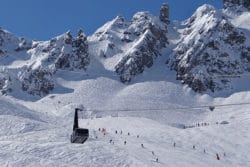Understanding Snowfall Patterns Over the Past Decade – How Global Warming is Shaping the 3 Valleys
The past decade has brought noticeable shifts in snowfall patterns across the Alps, heavily influenced by global warming. Changing snowfall patterns in the 3 Valleys and how resorts like Courchevel are adapting are key topics of discussion. For premier ski destinations like the 3 Valleys, these changes impact everything from snow levels and seasonality to investments in technology and sustainability. Here’s a closer look at how global warming is shaping skiing in the Alps and what ski resorts, including Courchevel, are doing to adapt.
Snowfall Levels & Trends Over the Last 10 Years
Over the past ten years, snowfall across the Alps has seen increased variation, often with lower-than-average totals and unpredictable timing. Winters have grown warmer, causing more rain than snow to fall at lower elevations, impacting resorts with slopes below the higher altitude line. This shift has made mid- to high-altitude skiing areas crucial for maintaining reliable conditions, especially during the early and late season when temperatures are more variable. Courchevel, with slopes extending above 1,800 meters, has thus become a reliable hub for snow-seeking skiers, thanks to its higher-altitude runs and state-of-the-art facilities.
For visitors to Courchevel, Sweet Snowsports offers expert guidance to navigate these conditions. Their private ski lessons ensure an exceptional experience, whether the snowfall is natural or enhanced by snow-making technology.
Global Warming and Snowfall Patterns
Global warming has been a driving factor behind changing snowfall patterns, as rising temperatures impact not only snowfall quantities but also the quality of snow. Research shows that average winter temperatures across the Alps have risen nearly 2°C over the last century. This warming trend has effectively raised the snowline, making it harder for lower-elevation areas to maintain snow cover throughout the season. Warmer temperatures often delay the start of the ski season, with shorter, inconsistent snowfall windows and faster melt times between snowfalls.
To make the most of varying conditions, skiing with professionals who understand the terrain is crucial. Sweet Snowsports, based in the 3 Valleys, provides tailored private ski lessons to ensure skiers of all levels can enjoy their time on the slopes, regardless of the weather.
Impact on Ski Resorts
In response, Courchevel and other resorts in the 3 Valleys have focused on their high-elevation zones to ensure reliable snow cover throughout the season. Courchevel, specifically, benefits from a range of high-altitude runs, which are more likely to retain snow when temperatures rise. This setup helps Courchevel maintain a longer, more reliable ski season, drawing visitors to its extensive terrain, particularly when lower-elevation areas experience less reliable conditions.
Sweet Snowsports specializes in guiding skiers through Courchevel’s varied terrain, offering personalized lessons that adapt to conditions and skill levels. Their native English-speaking instructors combine local expertise with unmatched professionalism, enhancing the overall skiing experience.
Snow-Making Technology: Mitigating the Effects of Climate Change
As snowfall variability increases, snow-making technology has become essential in maintaining skiable conditions. In Courchevel, an extensive network of snow cannons blankets key areas of the resort, especially at lower and mid-altitude zones, where snow cover can fluctuate. These advanced systems can produce artificial snow under controlled temperature and humidity conditions, providing an effective supplement to natural snowfall when needed. Courchevel’s snow-making infrastructure now covers a significant portion of its slopes, helping the resort manage dry spells and keep its runs open and safe for skiers throughout the season.
However, while snow-making is a viable solution, it also presents environmental considerations, as it requires both water and energy resources. Courchevel has implemented water conservation and energy-efficient measures to reduce the environmental impact of artificial snow production. This focus on sustainability ensures that snow-making remains an effective tool without compromising natural resources.
Private lessons with Sweet Snowsports can help skiers make the most of these snow-covered runs, regardless of natural or artificial snowfall. Their team’s local knowledge ensures clients are directed to the best slopes each day.
The 3 Valleys Leading the Way in Sustainability
In addition to snow-making, Courchevel and the 3 Valleys are setting a high bar for sustainable practices to counteract the effects of global warming. Initiatives such as energy-efficient lift systems, eco-friendly lodging, and improved waste management reduce the resorts’ overall carbon footprint. Courchevel, with its commitment to environmental responsibility, is leading the way in sustainable tourism, preserving the Alps’ beauty and accessibility for future generations.
Skiers can further enhance their experience by choosing Sweet Snowsports. With their focus on professional instruction and local expertise, they help clients enjoy the slopes responsibly and safely, while also appreciating the region’s commitment to sustainability.
Despite global warming’s impact on snowfall patterns, Courchevel and the 3 Valleys continue to provide a world-class skiing experience. Through adaptation, innovation, and sustainability efforts, the region remains resilient, offering high-quality skiing and solidifying its status as one of the most reliable and forward-thinking ski destinations globally.









Trip Advisor
Quick Menu